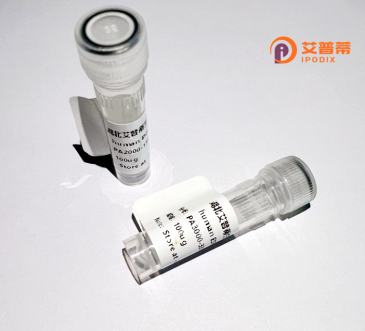
| 纯度 | >90%SDS-PAGE. |
| 种属 | Human |
| 靶点 | LEPRE1 |
| Uniprot No | Q32P28 |
| 内毒素 | < 0.01EU/μg |
| 表达宿主 | E.coli |
| 表达区间 | 23-736aa |
| 活性数据 | EVESEAGW GMVTPDLLFA EGTAAYARGD WPGVVLSMER ALRSRAALRA LRLRCRTQCA ADFPWELDPD WSPSPAQASG AAALRDLSFF GGLLRRAACL RRCLGPPAAH SLSEEMELEF RKRSPYNYLQ VAYFKINKLE KAVAAAHTFF VGNPEHMEMQ QNLDYYQTMS GVKEADFKDL ETQPHMQEFR LGVRLYSEEQ PQEAVPHLEA ALQEYFVAYE ECRALCEGPY DYDGYNYLEY NADLFQAITD HYIQVLNCKQ NCVTELASHP SREKPFEDFL PSHYNYLQFA YYNIGNYTQA VECAKTYLLF FPNDEVMNQN LAYYAAMLGE EHTRSIGPRE SAKEYRQRSL LEKELLFFAY DVFGIPFVDP DSWTPEEVIP KRLQEKQKSE RETAVRISQE IGNLMKEIET LVEEKTKESL DVSRLTREGG PLLYEGISLT MNSKLLNGSQ RVVMDGVISD HECQELQRLT NVAATSGDGY RGQTSPHTPN EKFYGVTVFK ALKLGQEGKV PLQSAHLYYN VTEKVRRIME SYFRLDTPLY FSYSHLVCRT AIEEVQAERK DDSHPVHVDN CILNAETLVC VKEPPAYTFR DYSAILYLNG DFDGGNFYFT ELDAKTVTAE VQPQCGRAVG FSSGTENPHG VKAVTRGQRC AIALWFTLDP RHSERDRVQA DDLVKMLFSP EEMDLSQEQP LDAQQGPPEP AQESLSGSES KPKDEL |
| 分子量 | 83.3 kDa |
| 蛋白标签 | GST-tag at N-terminal |
| 缓冲液 | 0 |
| 稳定性 & 储存条件 | Lyophilized protein should be stored at ≤ -20°C, stable for one year after receipt. Reconstituted protein solution can be stored at 2-8°C for 2-7 days. Aliquots of reconstituted samples are stable at ≤ -20°C for 3 months. |
| 复溶 | Always centrifuge tubes before opening.Do not mix by vortex or pipetting. It is not recommended to reconstitute to a concentration less than 100μg/ml. Dissolve the lyophilized protein in distilled water. Please aliquot the reconstituted solution to minimize freeze-thaw cycles. |
以下是关于重组人LEPRE1蛋白的3篇代表性文献概览:
---
1. **文献名称**:*Expression and characterization of recombinant human prolyl 3-hydroxylase 1 in Escherichia coli*
**作者**:Zhao et al. (2010)
**摘要**:该研究在大肠杆菌中成功表达并纯化了重组人LEPRE1蛋白(脯氨酰3-羟化酶1),证实其与伴侣蛋白CRTAP、CYPB结合形成复合物,并在体外验证其催化胶原脯氨酸残基羟基化的活性,为研究胶原修饰机制提供了工具。
2. **文献名称**:*Purification and structural analysis of the LEPRE1-encoded prolyl 3-hydroxylase complex*
**作者**:Bhattacharyya et al. (2009)
**摘要**:通过杆状病毒-昆虫细胞系统表达重组LEPRE1蛋白,结合质谱和冷冻电镜解析其三维结构,揭示了该酶复合物在胶原合成中催化特定羟化位点的分子基础。
3. **文献名称**:*Mutations in LEPRE1 impair collagen hydroxylation and cause severe osteogenesis imperfecta*
**作者**:Marini et al. (2010)
**摘要**:通过构建携带LEPRE1突变的细胞模型,研究发现重组LEPRE1蛋白功能缺失导致胶原羟基化异常,阐明了其突变引起成骨不全症的分子机制。
---
**说明**:
- 上述文献涵盖了重组LEPRE1蛋白在原核(大肠杆菌)和真核(昆虫细胞)系统中的表达、结构解析及其在疾病机制中的应用。
- 研究方向包括蛋白功能验证、结构分析及疾病关联,适用于分子生物学、结构生物学及医学研究参考。
如需补充其他领域(如药物开发),建议进一步检索关键词“重组LEPRE1”+“抑制剂”或“治疗应用”。
Recombinant human LEPRE1 protein, also known as prolyl 3-hydroxylase 1 (P3H1), is a critical enzyme involved in post-translational modification of collagen, particularly type I collagen. It catalyzes the 3-hydroxylation of specific proline residues in collagen α-chains, a modification essential for collagen’s structural stability and proper fibril assembly. LEPRE1 functions within the endoplasmic reticulum as part of a heterotrimeric complex with cartilage-associated protein (CRTAP) and cyclophilin B, facilitating collagen folding and quality control.
Mutations in the LEPRE1 gene are linked to osteogenesis imperfecta (OI) types VII and VIII, severe bone fragility disorders characterized by defective collagen hydroxylation and compromised bone mineralization. Recombinant LEPRE1 production, typically achieved via mammalian or insect expression systems, enables biochemical studies of its enzymatic activity, interactions with collagen and complex partners, and mechanisms underlying OI pathogenesis.
This recombinant protein also holds therapeutic potential, as restoring functional LEPRE1 could ameliorate collagen abnormalities in OI or fibrotic diseases. Research further explores its role in extracellular matrix homeostasis, tissue repair, and pathologies beyond skeletal disorders, such as cardiac fibrosis. Optimization of its recombinant expression continues to advance structural studies and high-throughput screening for targeted therapies.
×